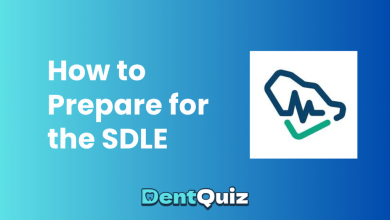Inside the SDLE Test Day: Rules, Expectations, and Smart Tips for Success

You’ve spent months studying, practicing, and preparing for the Saudi Dental Licensure Examination (SDLE). But when test day finally arrives, how you manage those six hours can make all the difference. This guide explains everything you need to know — from what to bring, how the exam environment works, to strategies that help you stay calm and perform at your best.
1. Understanding the structure of SDLE test day
The SDLE is a computer-based examination held at approved Prometric test centers across Saudi Arabia and other international locations. Each testing center follows strict security and professional conduct procedures. The total testing time is approximately six hours, divided into three sections of 100 multiple-choice questions each.
Between the sections, candidates are allowed a total of 45 minutes of break time, which can be divided based on personal preference. Some candidates prefer short breaks after every section, while others save most of their break time for later. Your approach should depend on how you handle fatigue and concentration.
2. What to bring on test day
Preparation starts before you even arrive. Here’s a checklist of what you must bring — and what to leave behind.
- Valid identification: A government-issued ID such as a passport, Saudi national ID, or residency card. Your ID must exactly match the name on your exam permit.
- Scheduling permit: Printed or electronic copy of your test confirmation, showing the date, time, and location.
- Personal comfort items: Light clothing layers, as test center temperatures may vary.
- Optional: A small snack or bottle of water for use during your breaks, if permitted by the center.
Do not bring phones, smartwatches, calculators, notes, or any recording devices. These items are strictly prohibited inside the testing area.
3. Arriving at the test center
Aim to arrive at least 30–45 minutes before your scheduled start time. Late arrivals (beyond 30 minutes) may be denied entry, and your session could be marked as “No Show,” counting as an attempt.
Upon arrival, you’ll check in with the Test Center Administrator (TCA). You’ll be asked to:
- Show your ID and scheduling permit.
- Sign the test roster (each time you enter or leave).
- Complete a security check, including pocket inspection and electronic scanning.
- Have your photo and fingerprint captured for verification.
Once checked in, you’ll be escorted to your computer station. A brief on-screen tutorial will explain how to navigate the exam software. Take advantage of this to familiarize yourself with the interface.
4. Security and conduct rules
The SDLE test centers maintain strict rules to ensure fairness and exam integrity. All sessions are video-monitored and audio-recorded.
Remember these key points:
- Electronic devices, bags, and study materials are not allowed in the test room.
- All clothing or jewelry items that you wear must remain on your person throughout the exam.
- Leaving your station repeatedly or taking long unscheduled breaks will be reported.
- Communicating with other candidates, verbally or non-verbally, is strictly prohibited.
- Harassment or unprofessional behavior toward test staff can lead to disqualification or legal action.
If you experience any technical issue, raise your hand and notify the TCA immediately — don’t try to fix the computer yourself.
5. Navigating the exam interface
Each question in the SDLE has four answer choices, with only one best answer. You can mark questions for review and return to them later within the same section. However, once you exit a section, you can’t go back to it.
- Use the flag option to mark uncertain questions.
- Track your time — each section has a fixed 120-minute limit.
- A timer at the top of the screen shows remaining time.
- Don’t panic if you see “pilot questions” — they are unscored items mixed in to evaluate future exam content.
6. Break management strategy
Breaks are your mental reset points. You’re given 45 minutes of total break time to split between the two intervals. Many successful candidates use 20 minutes after the first section, 25 after the second.
Use your break to:
- Stretch and move around to increase blood flow.
- Eat a light snack or hydrate — but avoid heavy meals that may make you sleepy.
- Mentally disconnect from the test for a few minutes to reset focus.
Arrive back 10–15 minutes early, as signing back in and security checks take time.
7. Time management during the test
With 100 questions per section and 120 minutes, you have just over a minute per question. Smart pacing is critical:
- Answer straightforward questions first — mark the tough ones for review.
- Avoid overthinking. Often, your first instinct is correct.
- If stuck, eliminate wrong choices and make an educated guess.
- Keep an eye on the timer — don’t let time run out on unanswered questions.
Practicing with mock exams before test day helps you build this pacing naturally.
8. Managing anxiety and staying calm
It’s normal to feel nervous during such a high-stakes test. The key is not to eliminate anxiety, but to manage it. Try these techniques:
- Breathe slowly: Deep breathing lowers your heart rate and helps you refocus.
- Positive self-talk: Replace “I might fail” with “I’ve prepared and can handle this.”
- Stay present: Focus on one question at a time rather than worrying about the overall result.
- Rest well: Sleep is more beneficial than late-night cramming the day before.
9. Common mistakes to avoid on SDLE test day
Even well-prepared candidates can lose marks due to simple errors. Avoid these common pitfalls:
- Skipping the tutorial and wasting time later figuring out navigation.
- Spending too long on a single question and running out of time at the end.
- Leaving early before reviewing marked questions.
- Ignoring exam-day rules — bringing phones or talking to others can result in immediate disqualification.
Remember, discipline and professionalism are as important as knowledge on test day.
10. After the exam: what happens next?
Once you finish all three sections, you’ll receive a confirmation on the screen that your test has been submitted. Results are not provided immediately. SCFHS typically releases results within two to six weeks after the testing window closes.
You’ll receive:
- A statement of results — showing your score on the 200–800 scale.
- A feedback report — detailing your performance by subject area.
Use this feedback to evaluate your preparation. If you pass, congratulations — you’re eligible to proceed with licensing or postgraduate training. If not, analyze weak areas and plan a focused retake.
11. Final takeaways
Success on SDLE test day is about preparation, composure, and discipline. Arrive early, follow the rules, manage your time wisely, and approach each question with a clear, confident mindset. Remember — this exam isn’t just testing what you know, but how you think as a safe and ethical dental practitioner.
Stay calm, stay focused, and trust the work you’ve put in. Every great dentist once faced this exact same challenge — and you’re ready to join them.
How to Prepare for the SDLE: A Step-by-Step Strategy for Dental Graduates




